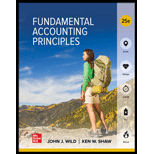
Concept explainers
(1) Equivalent units of production with respect to (a) conversion and (b)direct materials.
Concept Introduction:
Process costing is mainly used in manufacturing units, wherein bulk units of standard goods are produced at a time in lots. It is used for each department of production to determine the costs assigned to units transferred out and ending work in process.
Requirement 1
To Determine:
Equivalent Units of Production with respect to (a) conversion and (b) Direct Materials.
(2) Conversion Cost and Direct Material Cost per unit.
Concept Introduction:
Process Costing:
Process costing is mainly used in manufacturing units, wherein bulk units of standard goods are produced at a time in lots. It is used for each department of production to determine the costs assigned to units transferred out and ending work in process.
Requirement 2
To Determine:
Conversion cost and Direct Material cost per equivalent unit.
- Conversion Cost and Direct Material Cost Assigned to (a) completed and transferred units and (b) ending work in process.
Concept Introduction:
Process Costing:
Process costing is mainly used in manufacturing units, wherein bulk units of standard goods are produced at a time in lots. It is used for each department of production to determine the costs assigned to units transferred out and ending work in process.
Requirement 3
| Cost Assignment and Reconciliation | ||
|
Cost of Goods Manufactured | ||
| Direct Materials(700000*3) | 2100000 | |
| Conversion(700000*4.5) | 3150000 | 5250000 |
| Cost of ending work in process | ||
| Direct Materials(180000*3) | 540000 | |
| Conversion(54000*4.5) | 243000 | 783000 |
| Total Cost Accounted For | 6033000 | |
Want to see the full answer?
Check out a sample textbook solution
Chapter 20 Solutions
FUND.ACCT.PRIN.
- What is the ending inventory?arrow_forwardExercise 10-8 (Algo) Prepare the stockholders' equity section (LO10-7) The Golden Mushroom has two classes of stock authorized 8%, $10 par preferred, and $1 par value common. The following transactions affect stockholders' equity during 2024, its first year of operations January 2 February 6 Issues 100,000 shares of common stock for $28 per share. Issues 2,300 shares of a preferred stock for $12 per share. September 10 Purchases 10,000 shares of its own common stock for $33 per share. December 15 Resells 5,000 shares of treasury stock at $38 per share. In its first year of operations. The Golden Mushroom has net income of $153,000 and pays dividends at the end of the year of $95,000 ($1 per share) on all common shares outstanding and $1,840 on all preferred shares outstanding Required: Prepare the stockholders' equity section of the balance sheet for The Golden Mushroom as of December 31, 2024. (Amounts to be deducted should be indicated by a minus sign) THE GOLDEN MUSHROOM Balance…arrow_forwardI need help with this general accounting problem using proper accounting guidelines.arrow_forward

 AccountingAccountingISBN:9781337272094Author:WARREN, Carl S., Reeve, James M., Duchac, Jonathan E.Publisher:Cengage Learning,
AccountingAccountingISBN:9781337272094Author:WARREN, Carl S., Reeve, James M., Duchac, Jonathan E.Publisher:Cengage Learning, Accounting Information SystemsAccountingISBN:9781337619202Author:Hall, James A.Publisher:Cengage Learning,
Accounting Information SystemsAccountingISBN:9781337619202Author:Hall, James A.Publisher:Cengage Learning, Horngren's Cost Accounting: A Managerial Emphasis...AccountingISBN:9780134475585Author:Srikant M. Datar, Madhav V. RajanPublisher:PEARSON
Horngren's Cost Accounting: A Managerial Emphasis...AccountingISBN:9780134475585Author:Srikant M. Datar, Madhav V. RajanPublisher:PEARSON Intermediate AccountingAccountingISBN:9781259722660Author:J. David Spiceland, Mark W. Nelson, Wayne M ThomasPublisher:McGraw-Hill Education
Intermediate AccountingAccountingISBN:9781259722660Author:J. David Spiceland, Mark W. Nelson, Wayne M ThomasPublisher:McGraw-Hill Education Financial and Managerial AccountingAccountingISBN:9781259726705Author:John J Wild, Ken W. Shaw, Barbara Chiappetta Fundamental Accounting PrinciplesPublisher:McGraw-Hill Education
Financial and Managerial AccountingAccountingISBN:9781259726705Author:John J Wild, Ken W. Shaw, Barbara Chiappetta Fundamental Accounting PrinciplesPublisher:McGraw-Hill Education





